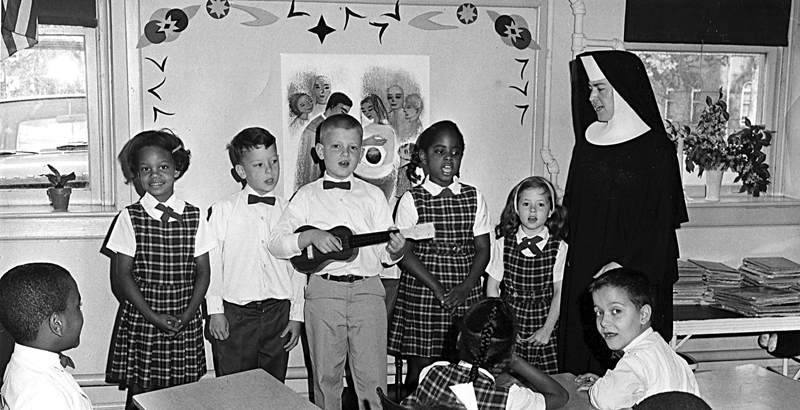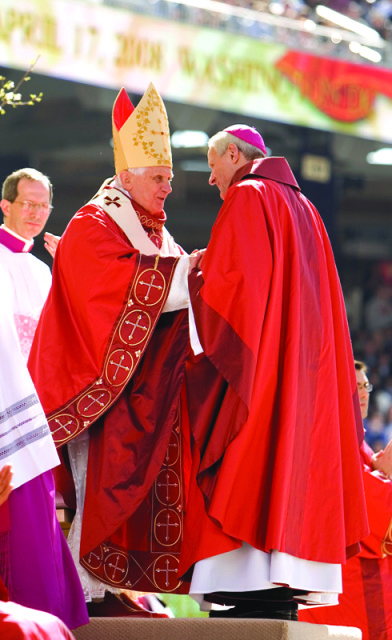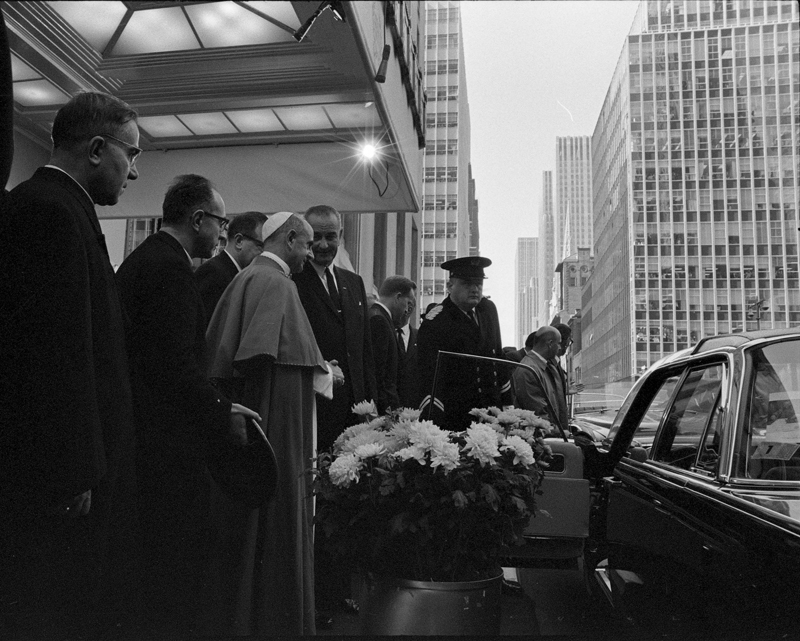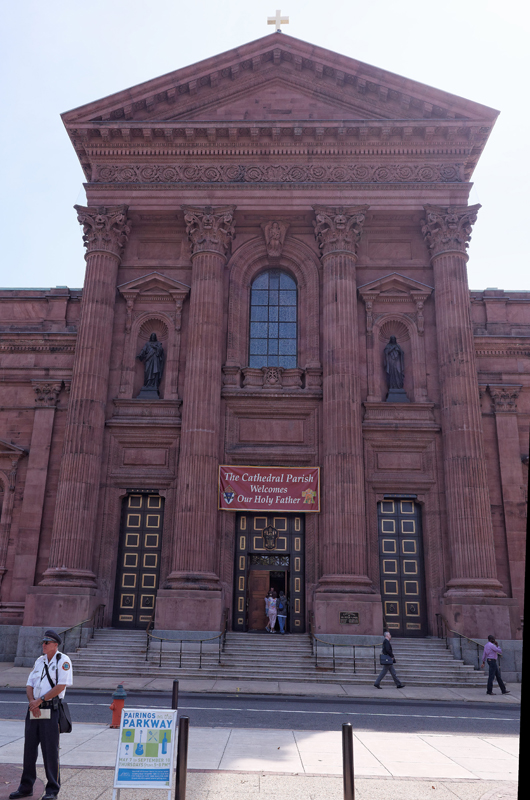
First-graders sing the “Our Father” at St. Anthony School in Washington in this 1967 photo. Photo courtesy of the Catholic Standard, newspaper of the Archdiocese of Washington
(RNS) Three influential cities on the Eastern Seaboard — Washington, New York and Philadelphia — will be Pope Francis’ destinations during his U.S. visit. Each, with its prominent archdiocese, has a unique history for Catholics. Here are snapshots:
WASHINGTON
The Archdiocese of Washington began in 1939, when it was separated from the Baltimore Archdiocese and solely included the city of Washington, D.C. (Until 1808, the Baltimore Diocese stretched from Canada to Florida.) The Washington Archdiocese expanded in 1947 to include five nearby counties in Maryland, the state where English colonists celebrated their first Catholic Mass three centuries earlier.
Francis will visit the first parish in the city of Washington, St. Patrick’s Church, which dates to 1794.
Until World War II, Washington was “essentially a Southern town” that didn’t attract the range of immigrants that were drawn to other cities, said the Rev. Rory Conley, historian of the Archdiocese of Washington.

Pope Benedict XVI greets Washington Archbishop Donald Wuerl during the celebration of Mass at Nationals Park on April 17, 2008. Photo courtesy of the Catholic Standard, newspaper of the Archdiocese of Washington
“The ethnic kind of church that you have in Philadelphia, with Irish, Italians and Germans … and New York, that never really happened here,” he said.
Although the archdiocese has long been known for its population of white and black Catholics, the diversity of ethnic groups, especially Hispanic Catholics, has increased in recent years, said Conley.
READ: Who is Pope Francis? Insights on the remarkable life of a historic pontiff
The Washington Archdiocese became a center of Catholic education, including the Catholic University of America, Georgetown University and what is now known as Trinity Washington University, a liberal arts institution that includes an undergraduate college for women.
The archdiocese also was a landmark in education for younger students. Archbishop Patrick O’Boyle, who was later named a cardinal, started integrating the archdiocese’s Catholic schools in 1948, six years before the Supreme Court ruled in Brown v. Board of Education that public school segregation was unconstitutional.
NEW YORK
The first parish in New York, St. Peter’s Church, was founded in 1785, more than two decades before the New York Diocese was one of several carved out of the Diocese of Baltimore. In 1850, after the Dioceses of Albany and Buffalo were created, it became the Archdiocese of New York.
READ: The ‘Splainer: What is the World Meeting of Families?
New York was the first U.S. city to be visited by a pope — Pope Paul VI on Oct. 4, 1965.
“He arrived at 9:30 in the morning at JFK Airport and left around 11 o’clock that night,” said the Rev. Michael Morris, archivist of the New York Archdiocese.
Paul started a papal tradition followed by three others — John Paul II, Benedict XVI and, soon, Francis — to visit St. Patrick’s Cathedral in the city’s cultural center. Pope Pius XII visited when he was a cardinal.
“A lot of people call it America’s church,” said Morris. “No other church outside of Rome has been visited by a pontiff as many times as St. Patrick’s has.”
MORE: Pope Francis to visit US churches of history, grandeur and power

President Lyndon B. Johnson greets Pope Paul VI at the Waldorf-Astoria in New York City on Oct. 4, 1965. Photo courtesy of the National Archives and Ronald Reagan Presidential Library (public domain)
New York archbishops have long been influential on the political scene, underscoring the archdiocese’s reputation as a powerhouse.
Cardinal Francis Spellman, who became archbishop in 1939 and remained in the role for almost three decades, befriended President Franklin Roosevelt and British Prime Minister Winston Churchill.
Spellman prepared the archdiocese — long dominated by Irish and Italian Catholics — for an influx of Hispanics by sending priests to Latin America to learn Spanish as early as the 1950s, Morris said.
Many Catholics moved out of the city after World War II, and the changing demographics — including fewer men seeking the priesthood — forced the closure of some churches with small congregations while others continue to thrive.
“The fact that we’ve been able to maintain these parishes 70 years after the victory in Europe, the victory in the Pacific, I think speaks volumes for the staying power of the Catholic Church,” said Morris.
PHILADELPHIA

The Cathedral Basilica of Saints Peter and Paul welcomes Pope Francis. Religion News Service photo by Michael O’Sullivan
Catholics in Philadelphia celebrated Mass publicly as early as 1707, and the first church, Old St. Joseph’s Church, was built in 1733.
“It was priests from Philadelphia who would be the circuit riders going through New Jersey, up into New York City, to reach Catholic populations in those colonies,” said Thomas Rzeznik, author of “Church and Estate: Religion and Wealth in Industrial Era Philadelphia.”
In the decades after the creation of the Philadelphia Diocese in 1808, there were anti-Catholic riots and some churches were burned.
“Philadelphia is where anti-immigrant violence and anti-Catholic hatred were strongest in our country,” said Philadelphia Archbishop Charles Chaput, speaking to journalists at a recent Religion Newswriters Association meeting there. “But ironically it’s also the only place during the Colonial period that tolerated Catholic public worship.”
READ: Pope calls for ‘revolution of tenderness’ in Cuba
Bishop John Neumann, who was later canonized as a saint, was instrumental in starting the first parochial school system. Mother Katharine Drexel, also now a saint, founded the Sisters of the Blessed Sacrament, known for its outreach to black and Native American children.
The city’s parishes were dominated by Irish Catholics, but separate ethnic parishes included Italians, Poles and Germans. Black Catholics date to the 1700s in Philadelphia. The presence of Hispanic as well as Asian Catholics has grown in the last half-century.
In recent years, Chaput has restructured the archdiocese after it was wracked with sex abuse and financial scandals and the closing and merging of churches and schools.
Many hope that the pope’s visit will re-energize the people of Philadelphia’s archdiocese.
“I think people are looking for this moment for a sense of revitalization and reaffirmation of Catholicism in Philadelphia,” said Rzeznik.
LM/MG END BANKS





